Emergency food storage is a must-have in long-term survival situations: be it freeze-dried emergency food or the one served from tins, a meal, especially with substantial shelf life, will fuel any survivalist.
Vegetarian people can also find survival freeze-dried food appropriate for them. However, a severe threat may cause even them to eat meat to survive.
This article will tell you all about survival food storage and every survivalist and self-reliant practician’s items in the meal kit.
What also matters is your ability to be aware of how to act in any situation and your survival skills. The proper survival gear in your backpack can significantly improve your chances. Once you are able to grow food for survival by yourself, you are lucky. But you should, of course, do it as properly as you can. Thus, you will have a real chance to build substantial food storage!
Start Your Emergency Long Term Food Storage System With The Help Of Long-Term Emergency Food Kits
At first glance, survival emergency food supply storage seems pretty easy to create: all you need to do is to get yourself a cooler bag or a big chest freezer and stuff it with your freeze-dried food provisions, from meatloaves and slices of cheese to veggies and other frozen meals. So do you think you are set now?
Well, no such luck…
Unless you’ve contributed to a very complex backup power network to take with you, your freezer is not much worthier than an ordinary cardboard box: one should prepare for the fact that any freeze-dried foods’ shelf life is on the final countdown once the power is out.
Emergency Food Supply Deserves a Better Solution
That is the reason why today we invite you to discuss the following emergency food stockpile issues:
- Why You Should Never Lean Only On Your Freeze Dried Emergency Food
- Best Ways To Start
- How To Use Long Term Food Storage As A Bargaining Tool
- Basic Emergency Food Storage Tips And Hacks
- “Do It Yourself,” “Done For You” Concepts Or Both?
- Saving Money On Long Term Food Supplies
- What Sorts Of Freeze Dried Food Should I Buy?
- How To Maintain Your Food Supply
- How to Make Sugar at home
- and much more.
Why You Should Never Lean Only On Your Freeze Dried Emergency Food
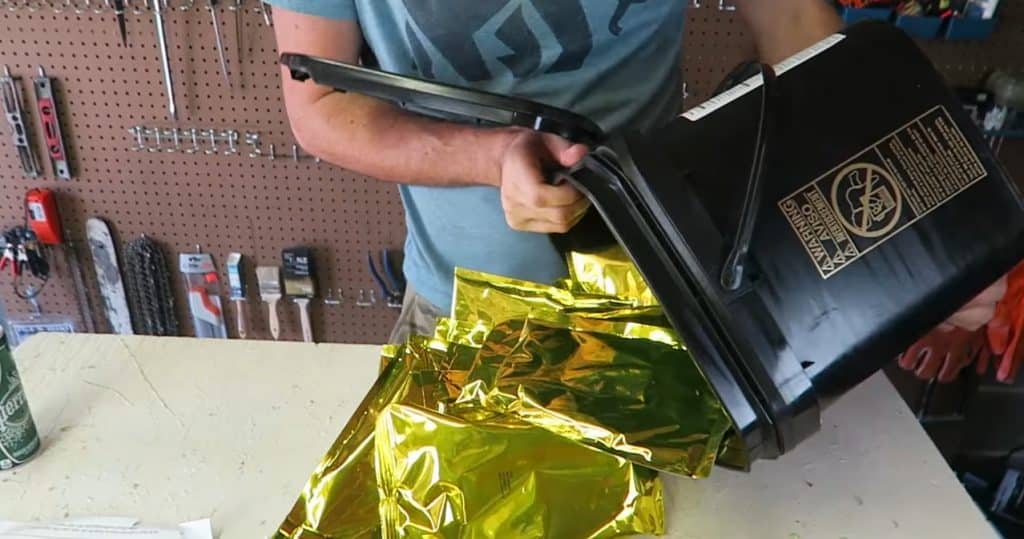
Sooner or later, those freeze-dried food supplies will end up at my dinner table, where my family will eat them. But most people live alone/in a couple and just don’t need that.
Large chest freezers are a must convenience for a modern family, as it only takes minutes and almost no skills to thaw, cook, and eat any dehydrated foods you store there. So, additional dishes, fish and canned meats, cheeses, desserts, and whatever may calmly wait for big company visits and holiday family dinners.
As you can see, there are dozens of advantages in owning and using a big freezer, though survival freeze-dried food storage is a totally different story.
Also matters
Is there, in fact, any natural or human-caused disaster that may guarantee a trustworthy supply of grid power for maintaining your food in good condition?
- Terrorist Nuclear Attacks? Not for sure.
- Natural disasters? Definitely not!
- EMP Attack? I doubt that.
- Civil Unrest and Riots? Not really.
Thus, the first freezer feature that serves as a disadvantage in emergency food storage is its grid dependence.
When The Grid Goes Down, Your Fridge Simply Stops Freezing.
The case when you store the freezer in your garage or barn, and it’s below 30 degrees outside, does not count for the foreseeable future.
Even if you have an emergency solar generator at your disposal and may switch it on and off whenever you want, letting your food storage last for weeks, and what happens if the electricity is cut right in the middle of a heatwave?
Luck should never be on top of survivalists’ basic vocabulary. Not only in a movielike survival scenario but in any long-term cut-off, you’re simply going to lose all the frozen food storage for nothing.
In that case, the bread will usually last for a bit more than a week, cheeses won’t spoil overnight, but the meats and many other frozen foods … will go off just within days. So you have to prepare for that.
Even if you’ve got a big and hungry family with ten kids, there are few chances to cook and eat all meat and other food supplies before they get spoiled.
Besides, the problem of common survival indecisiveness comes into play.
Once it has happened, any survivalist is stuck with questions like:
- Will they turn on grid power within a few days? Then it’s best to keep the fridge closed and try to prevent as much cold air from escaping as possible.
- What if it is a weeks/months-long sort of a power grid failure scenario? Then the only solution is to cook and eat as much of your meat supplies as possible right now.
Rotten beef or chicken food supplies will be another problem to face, as it is already stored unwisely and will only get rancid more through days. In addition, it will attract unwanted attention from your neighbors, rodents, or even wild animals.
If we finally convinced you that even a huge stocked freezer is not a reliable emergency long-term food storage option, let’s switch to the next point.
Grocery stores?
How about your local grocery store in case of a sudden survival situation? You evidently cannot rely on the grocery store for shopping and creating your emergency food stockpile because, in a real emergency, it will surely empty in hours and will unlikely be restocked soon, not to mention the worst-case survival scenario.
To start with, a good solution would be thinking of shopping for top-quality packaged freeze-dried meals, long shelf-life products, canned food, and keeping them before an emergency of any kind happens.
We are not trying to assure you that it seems too late to start if you still do not have food survival storage. Unfortunately, like many of our compatriots, in our kitchen, we only have the amount of food lasting for some days at best… but we are up to some emergency food kits hacks and principles.
Below is a summary of some of the striking findings from our 2020 poll of U.S. adults:
- 44 percent don’t have first-aid kits
- 48 percent lack emergency supplies for their basic needs
- 53 percent do not have a minimum three-day supply of nonperishable food and water at home
- 55 percent believe local authorities will come to their rescue if disaster strikes
- 52 percent have not designated a family meeting place if they are separated during an emergency
- 42 percent do not know the phone numbers of all of their immediate family members
- 21 percent don’t know if their workplace has an emergency preparedness plan
- 37 percent do not have a list of the drugs they are taking
- 52 percent do not have copies of health insurance documents
October 26, 2012, Adelphi University CHI Poll: Emergency Preparedness in the United States
As the recent data shows, more than half of Americans do not have a nonperishable food and water supply for at least three days worth, which means that their emergency preparedness is equal to zero. As a result, they would not have anything to eat when a disaster happens.
Basic Survival Food Storage Tips And Hacks

- Your meal should not be perishable. Free-dried meals (fruits and vegetables also), canned goods, dried foods in bulk, or dried meat products like pemmican. Not only may they last for months and years, living a shelf life, if kept and sealed right, providing you with the necessary for basic needs food supplies even for the worst-case situations, but they may offer quite a few various cooking options, as well. For this reason, if you are heading for a super-market this week, consider taking some of those food products into your shopping cart — prepare just in case.
- Think if you can buy and store processed food beforehand. Nutritionists generally say it is not very healthy to eat it, but it lasts longer than organic products, outweigh any potential drawbacks. In a survival scenario, choosing between starvation (which almost always equals death) and processed foods with the longest shelf life will not probably be long and controversial. Bothering about enhancing health is wiser only when the disaster ends; bothering about surviving and what is possible to eat is the most reasonable thing to do when the crisis is the new normal.
- Seek and prepare a cool and dry place for your emergency food supplies. A dry basement would be good enough, though not the perfect one. Still, keep in mind that there will be no point in emergency food storage if you do not store it dry, cool, and away from vermin and harmful bacteria.
- Work out and note the daily amount of calories every family member needs. Then calculate the proper amount of food you need to satisfy your survival food needs (tip: when in a survival mode, the necessary amount of calories required for one person to eat and keep going is on average twice bigger than when casually sitting in front of your PC reading an article like this, which only makes sense, right?).
The planner offer
Another basic principle not to ignore is to include more variety of food in your menu and not forget about some comfort. If you think that unique options and comfort are worthwhile and beneficial when choosing a restaurant on Friday evening, you are probably wrong. In a survival situation, variety will be more essential than one may think.
Imagine a long-term emergency: your relatives, kids, and everyone around is feeling low, frustrated, terrified, and unsure of the future; in this case, eating the same elementary foods day by day would only aggravate this overall mental state.
On the contrary, including more products and taste into the daily survivalists’ meals and having them in your emergency food supplies will cheer everyone up a bit, providing more or less proper nutrients with the minimum required variety of micro and macroelements and minerals – and that is a thing of utmost importance in a disaster mode.
Convenience is crucial as well when adapting to the new norms dictated by such a mode. So, if you have stored enough ready-made, easy-to-cook-and-eat food in advance, you are among the best-prepared ones.
Canned foods, such as tuna, salmon, herring, meats, beans, or even fruits and vegetables are highly suitable for that as you can simply open the can and eat it with no preparation required (so does a six-year-old kid, and this is a huge asset whatever the survival situation).
They also have a long shelf life and decent taste. But find a good emergency food supplier for shopping so that your canned dishes and any other staples would be of high quality.
Best Ways To Start Building Your Emergency Food Supplies
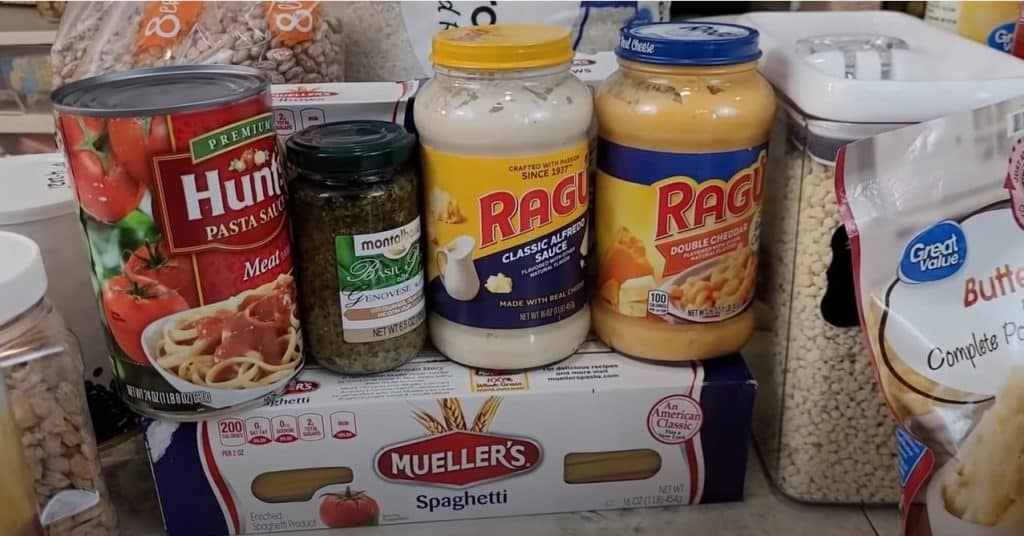
The alternative option is to seek and clean out the existing storage spaces, pantries, closets, etc. When getting rid of things, remember the golden storage rule that says: the items you do not use for a year or more are usually the items you do not need at all.
Once you are done with that, you will probably be surprised how much space you actually own to store extra products and emergency food supplies. You do not need an extra bunker for that — it is mostly a matter of organizing, planning, reasonably counting the space, and keeping your foods in a low-temperature range.
Slowly but surely, we kindly advise you to start wiping free space for your just-in-case food storage now.
Parallel to this, it is wise to figure out and prepare your emergency essentials, i.e., the minimum amount of how much food is required for each person to eat, including daily calorie “dose” (calories per kilogram, including such factors, as age, gender, height, health, activity, and so on), food preferences and any special diets, combined with products indispensable for survival.
Make sure to take down any specific alimentary or disease-related requirements for your close ones, and do not forget about food with a long shelf life and decent taste before going shopping for your storage.
Moreover, when having small children, ready-to-feed formulas might be in need.
These points are crucial to keeping in mind, so we kindly advise you to take notes.
Create a file with all of this information (a physical copy is better here than a digital one) and store it with your food supplies. It is essential to understand exactly what each family member requires each day to survive and keep going, whether there are any special dietary needs, what are the products one is allergic to or simply does not like to taste and eat at all — believe us, it’s worth it when you begin organizing your emergency food stock.
“Do It Yourself,” “Done For You” Concepts or Both?
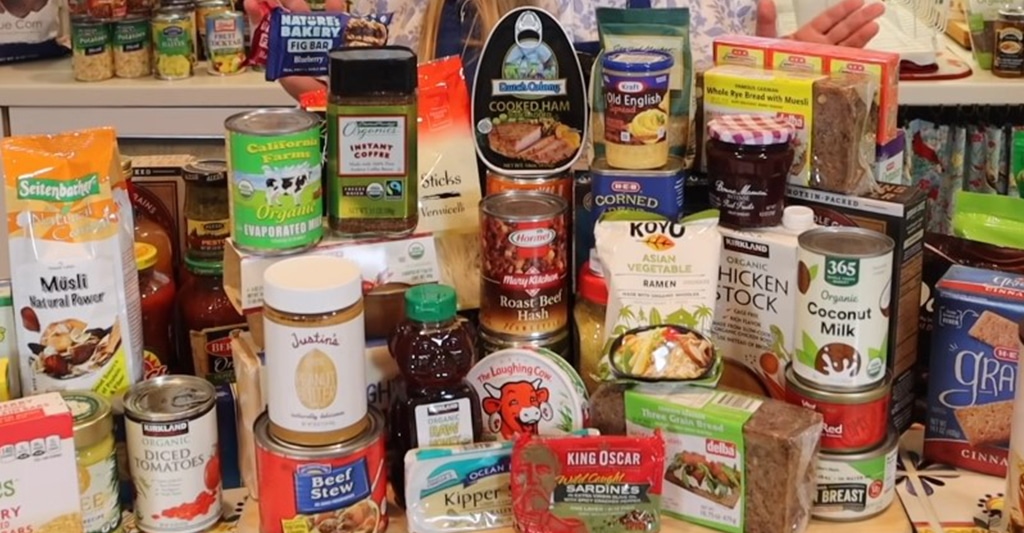
Shopping for a three-day supply of emergency essentials, such as prepared meals, is considered optimal for a newbie prepper that is not using the services of an emergency food supply.
When you feel you have already mastered it, focus on a bigger shopping mission and building up longer-term food storage, for example, a one-month-long amount of emergency essentials.
One-month shelf life of food storage will be sufficient for almost 99% of emergency cases, starting from taking refuge in the bunkers caused by a natural disaster to intentional terroristic attacks on the power grid.
After that, if you still do not feel fully tranquil and prepared, you may proceed to organize a one-year shelf-stable supply in several months or a year. Otherwise, you may want to acquire a consistent amount of freeze-dried foods or bulk specialty sealed foods from a survival food storage that is a much simpler method.
We personally recommend shopping in Valley Food Storage Company that offers lots of shelf-stable product storage options at varying prices and decent taste. It would be a nice survival food company for any emergency storage, a wilderness picnic, during a short-term cut-off, long trekking, camping adventure, and much more.
Valley Shelf-Stable Food Storage simply lets you a lot
- get prepared sooner
- stay calm and easy
- not to worry about the quality of packaging and keeping your emergency food
- enjoy the taste and store the food well-preserved for a very long time
A combination of two options – both DIY and Done For You seems to be an optimal solution, and we recommend including a Valley Food Storage in your monthly budget plan today. Hence you will always be ready to take an initial order of survival meals with you, and then you can stop at this point or continue arranging longer-term emergency supplies sometime after.
How to choose what to buy and store from Vally Food Company? — Here is the VIDEO of Valley Food Storage Walkthrough where you can see me choosing the necessary long-shelf-life items to purchase from Valley Food Storage to fulfill my survival food storage. Besides, Valley emergency essentials provide a 100% satisfaction guarantee to its series of products, so you as a customer can always rely on the brand’s quality or simply ask for a refund back.
Still, as an all-secure variant, we recommend targeting at least a one-year emergency food storage, which will be necessary for a total disaster. You could undoubtedly use your emergency meal as a survival and bargaining tool in the event of an economic collapse.
Besides, the one-year survival food kit is the ultimate lifeline if the war outbreaks on its own soil. Sooner or later, you will be able to use it to bargain with others in need of some emergency essentials.
We will tell you about bargaining later, though…
Saving Money on Survival Long Term Food Supplies

The prices, including those for alimentation, increase day by day: that is why you should think about the emergency food supply as a long-term project and shop mindfully. Since high cost and hidden food inflation is not under explicit and strict control on the market, try buying at least some extra cans (those with double oxygen absorbers would be the best choice) of fish, meat, or fruit each time you go shopping.
After a few months, that will gradually shape a substantial emergency food stockpile.
Another tip: store a page from the coupons book, check them in newspapers, in stores, or browse them online. The “Coupon Fans” generally save a solid amount of their budget (from hundreds to thousands of dollars) at the supermarket by simply buying in bulk for your emergency essentials pile.
Keeping notes of the stores’ special sale dates or double coupon offers could be a beneficial hack for those on a tight budget. Instead of being wasted on spontaneous “hungry” purchases, your budget could be saved for more reasonable and long-term investments. Mind that dollar stores and pharmacies may sell products at reduced prices, too.
There’s a different DIY route as well — try buying a good food dehydrator, a wise company in long-term storage that can dehydrate fruits and meats in a few simple steps.
Have you learned how to make pemmican, or hardtack yet, by the way?
Consequently, one doesn’t need to empty your bank account to set an emergency food stock. Instead, it can be easily accomplished by applying the “a can per day” principle.
What Sorts Of Survival Freeze Dried Food Should I Buy?

Generally, starter kits should include long-lasting products, freeze-dried food, and meals that do not require cooking. But, again, if any emergency outbreaks, finding non-perishable products close to the family’s daily menu is a very stabilizing factor that makes this transition less stressful.
Firstly, get these longer-term emergency staples beforehand: these will prolong your survival, even if your diet is boring or even Spartan.
Secondly, other valuable products to add to your shopping cart and meals are those with high energy value — peanut butter, dried fruit, mixed nuts and nut bars, trail mix, saltine crackers, and some others.
SPAM deserves to be mentioned among the best meal solutions – this market’s long-player has helped many people survive through the Great Depression and World War II.
We also recommend you consider becoming a customer of some company and buying good-quality food buckets (for example, Legacy Premium Breakfast Bucket or Mountain House Adventure Meal), which usually contain over two hundred meals in reliable, long-lasting packages that only need boiling water for cooking. In addition, some brands boast an impressive variety of survival food items and make their products right in-house, such as Wise Food located in a Salt Lake City facility or Augason Farms.
Are you one of the fancy gourmets in your daily life?
A beef stroganoff (in its survival version, of course) and noodles will go since Mountain House already provides the connoisseurs like you with long-lasting yet delicious meals that require only boiling water.
Moreover, the salt usually works as a great preserving factor, allowing these products and meals to last for years, even if they stale a bit or become not as crispy as they used to be. Finally, the peanut butter and trail mix are famous for solid amounts of protein and generally high nutrients value, given that Mountain House beef will be over or be spoilt soon unless you master the art of hunting.
There are many freeze-dried survival food kits worth investing your money in, for instance, Valley Food Storage, Legacy Emergency Food, Mountain House, Augason Farms, Peak Refuel series, or Wise Food Company located in Salt Lake City, to name just a few. Becoming a customer of either company would be a great investment in your future.
Keeping Your Emergency Food Supply
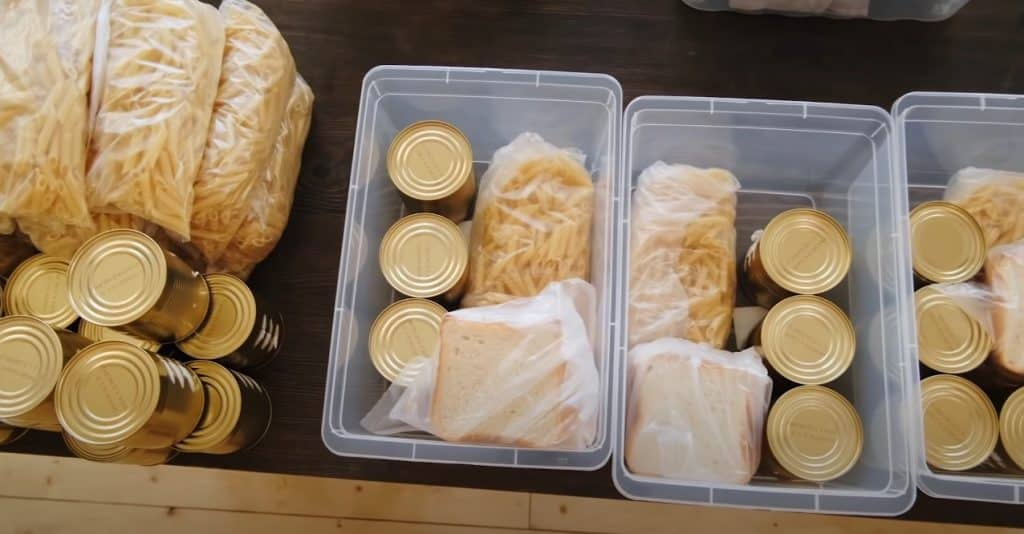
Apart from oats, rice, or sugar, many bucket food items and meals are considered to last up to 25 years (or even more!) if kept properly in a cool, dry, and dark place. Nevertheless, the “first in, first out” food rotation principle will definitely help to arrange your food supplies, be it buckets or tin cans.
Here’s a video explaining this principle in more detail to help you figure out mastering and applying it to emergency food stock rotation.
To optimize your rotation strategy, we offer you buying a can storage rack — it will save you from wasting your cash on extra food because you will be efficiently managing your stockpiled foods depending on its shelf life, necessity, best before the date on.
To put it shorter, such a rack will help you not forget about some ancient out-of-date cans on the bottom of your stock basement.
There are surely more additional methods of keeping products for years ahead. For example, cans with double oxygen absorbers last up to 25 years of shelf life.
And still, your starting point is becoming a reasonable customer and a wise planner, to count exactly what amount of calories your family needs per day and fill in the food kits gradually and systematically when going to the grocery stores.
How To Use Long Term Food Storage As A Bargaining Tool
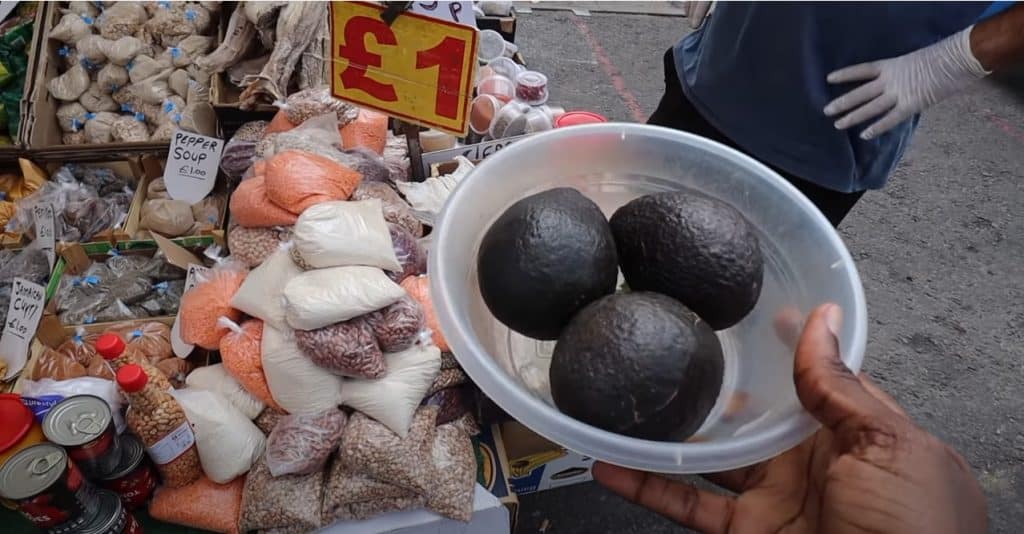
When society is no more than an abstract concept, wealth and status do not matter anymore; surviving meals do, though, having consistent food stocks, give you not only an extra bargaining tool but a massive extra chance of survival. Thus, you can trade food in exchange for safety, other goods, or even the necessary information.
Even if you do not have a bunker full of food stocks and your emergency supplies fit in backpackers’ pantry, it may still be the saving tool, and it is of vital force that you care about such storage backpacks in advance.
When you come across other people, trading meals for any other supplies may last you longer or even save you as it will be the only recognized currency of value in case of disaster outbreaks.
Conclusion
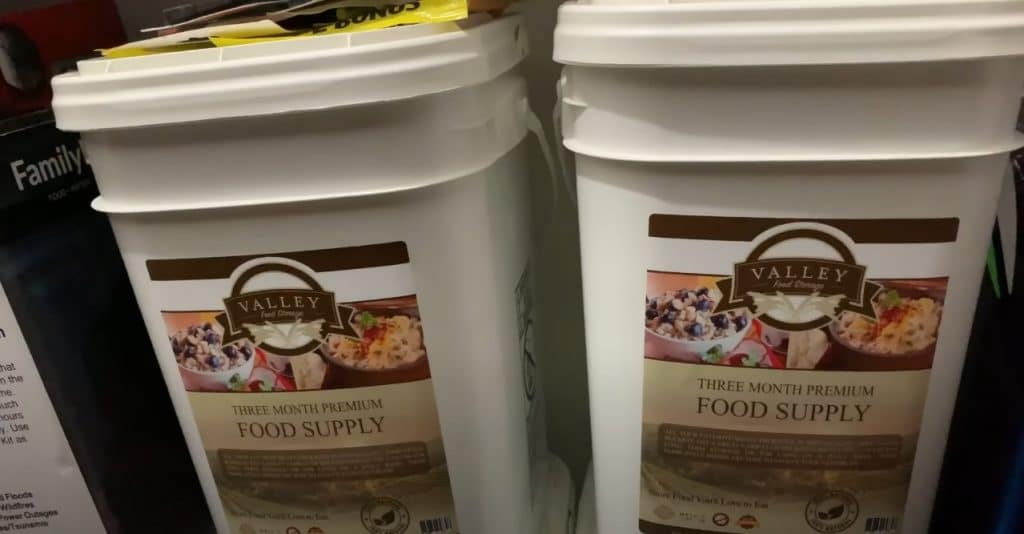
When a catastrophe strikes, it is evident that this will be a “no-excuses” situation: everyone will be caring for themselves, and no one will be able to rely on the government. And what is a tragedy for a certain person may become just another statistic to be mentioned by the government or regretted by fellow survivors.
Regard bugging out safe and sound as your ultimate mission.
Storing clean water, nonperishable food, ready-to-eat meals (such as powdered milk, eggs, dried vegetables, and canned beans), and mastering basic survival skills are the three sides of equal importance, contributing to the only important target — survival.
Keep in mind: to Prepare is already half a survival deal. To Adapt and Overcome is another one.
Sign up for our newsletter and leave your email address to get our new articles and recent updates sooner.
Frequently Asked Questions (FAQ)
How many emergency food supplies to purchase?
First, purchase at least a three-day food supply per person, the exact nutritional value depending on the age, gender, weight, and other specific requirements.
The more advanced level would be stocking a one-month (and further — a year-long) food supply of ready-to-eat meals.
How to store your emergency supply?
As we have already mentioned,
- Provide enough space – be it a basement, a garage, or a pantry; make sure it is dry (no moisture, no condensation if possible), cool (or close to room temperature), and relatively dark place out of kids’ reach;
- Consider buying long term storage can rack to optimize food rotation;
- Apply a “first-in, first-out” strategy to your survival gear food stockpile and systematically check the products’ terms of use and expiration dates.
What to look for in a survival food company?
Seek reasonable prices, 100% satisfaction/refund-back guarantee, good-quality packaging and extended shelf life, personally convenient (and free, if possible) shipping options for big orders (however, most orders do not take more than one week to ship).
Also, check out the coupon policies, current offers, and other bargains on the company’s website or use the company’s customer service directly. In plus, it is always useful to read consumers’ reviews anywhere on the Internet.
What About MREs?
Although MRE (Ready-to-Eat meal) is considered a perfect solution for short-term storage for disaster and emergency scenarios (as you can go without a stove or fire to boil water and do not have to take a can opener), such meals still have their drawbacks in terms of nutritional value: MRE meals don’t taste that good, contain an insufficient amount of fiber, but enormous amounts of fat (in case you do not know, they served for soldiers requiring instant energy on the battlefields during wars), too much salt, and in plus a lot of water to maintain proper digestion.


